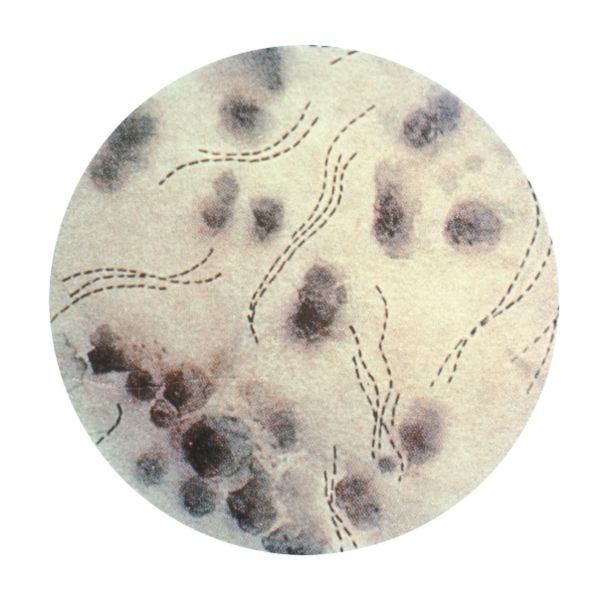Haemophilus ducreyi: Difference between revisions
Jump to navigation
Jump to search
| Line 24: | Line 24: | ||
*''Haemophilus ducreyi'', also known as ''H. ducreyi'', is a [[Growth medium|fastidious]], [[gram-negative]], coccobacillus that causes the [[sexually transmitted disease]] [[chancroid]], characterized as a genital ulcerative disease.<ref name="ChancroidMedscape">Chancroid in Emergency Medicine. Medscape (February 12, 2014). http://emedicine.medscape.com/article/781520-overview#showall Accessed January 12, 2016.</ref> | *''Haemophilus ducreyi'', also known as ''H. ducreyi'', is a [[Growth medium|fastidious]], [[gram-negative]], coccobacillus that causes the [[sexually transmitted disease]] [[chancroid]], characterized as a genital ulcerative disease.<ref name="ChancroidMedscape">Chancroid in Emergency Medicine. Medscape (February 12, 2014). http://emedicine.medscape.com/article/781520-overview#showall Accessed January 12, 2016.</ref> | ||
*''H. ducreyi'' was originally classified as a ''Haemophilus'' species due to its growth requirements and antigentic relatedness to other species in the genus. However, rRNA analysis indicates ''H. ducreyi'' is not a true ''Haemophilus'' but is more closely related to the [[Pasteurellaceae]] family.<ref name="Spinola2002">{{cite journal|last1=Spinola|first1=S. M.|title=Immunopathogenesis of Haemophilus ducreyi Infection (Chancroid)|journal=Infection and Immunity|volume=70|issue=4|year=2002|pages=1667–1676|issn=00199567|doi=10.1128/IAI.70.4.1667-1676.2002}}</ref> | *''H. ducreyi'' was originally classified as a ''Haemophilus'' species due to its growth requirements and antigentic relatedness to other species in the genus. However, rRNA analysis indicates ''H. ducreyi'' is not a true ''Haemophilus'' but is more closely related to the [[Pasteurellaceae]] family.<ref name="Spinola2002">{{cite journal|last1=Spinola|first1=S. M.|title=Immunopathogenesis of Haemophilus ducreyi Infection (Chancroid)|journal=Infection and Immunity|volume=70|issue=4|year=2002|pages=1667–1676|issn=00199567|doi=10.1128/IAI.70.4.1667-1676.2002}}</ref> | ||
*''H. ducreyi'''s genome is a single 1.7-Mb chromosome. | |||
==Human Pathogen== | ==Human Pathogen== | ||
Revision as of 20:09, 12 January 2016
|
Chancroid Microchapters |
|
Diagnosis |
|---|
|
Treatment |
|
Case Studies |
|
Haemophilus ducreyi On the Web |
|
American Roentgen Ray Society Images of Haemophilus ducreyi |
| Haemophilus ducreyi | ||||||||||||||
|---|---|---|---|---|---|---|---|---|---|---|---|---|---|---|
 Photomicrograph of H. ducreyi
| ||||||||||||||
| Scientific classification | ||||||||||||||
| ||||||||||||||
| Binomial name | ||||||||||||||
| Haemophilus ducreyi (Neveu-Lemaire 1921) Bergey et al. 1923 |
This page is about microbiologic aspects of the organism(s). For clinical aspects of the disease, see Chancroid.
Editor-In-Chief: C. Michael Gibson, M.S., M.D. [1]; Associate Editor(s)-in-Chief: Yazan Daaboul, M.D.; Nate Michalak, B.A.; Serge Korjian M.D.
Overview
Haemophilus ducreyi is a fastidious Gram-negative coccobacillus causing the chancroid characterized by painful sores on the genitalia.
Organism
- Haemophilus ducreyi, also known as H. ducreyi, is a fastidious, gram-negative, coccobacillus that causes the sexually transmitted disease chancroid, characterized as a genital ulcerative disease.[1]
- H. ducreyi was originally classified as a Haemophilus species due to its growth requirements and antigentic relatedness to other species in the genus. However, rRNA analysis indicates H. ducreyi is not a true Haemophilus but is more closely related to the Pasteurellaceae family.[2]
- H. ducreyi's genome is a single 1.7-Mb chromosome.
Human Pathogen
- H. ducreyi is an obligate human pathogen.
References
- ↑ Chancroid in Emergency Medicine. Medscape (February 12, 2014). http://emedicine.medscape.com/article/781520-overview#showall Accessed January 12, 2016.
- ↑ Spinola, S. M. (2002). "Immunopathogenesis of Haemophilus ducreyi Infection (Chancroid)". Infection and Immunity. 70 (4): 1667–1676. doi:10.1128/IAI.70.4.1667-1676.2002. ISSN 0019-9567.